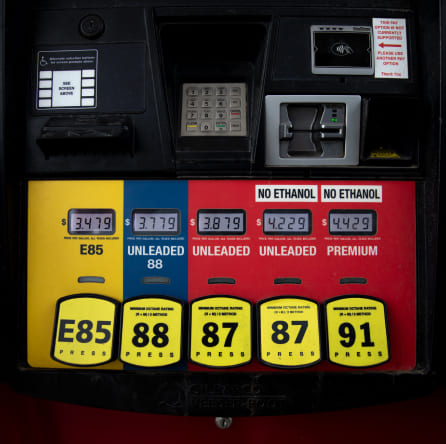
While ethanol has been added to fuel for decades, not everyone understands why. Below are some E15 basics and a list of questions frequently asked by retailers.
- E15 Basics
- Why are consumers interested in mid-level ethanol blends?
- What are the benefits of offering E15?
- How large is the market for E15?
- What is the installation process like?
- Does Growth Energy provide marketing materials?
- How many flex fuel vehicles (FFVS) are on the road today?
E15 Basics
E15 – unleaded gasoline mixed with 15 percent ethanol – is approved for use by the EPA for cars 2001 and newer.
- More than 96 percent of the vehicles on the road today are approved for using E15.
- Consumers have driven more than 90 billion miles on E15.
- Provides the same mileage as 87 regular, according to a recent Department of Energy Catalyst study.
- Produces lower emissions than regular gasoline, reducing the amount of toxins and greenhouse gasses in the air.
- Ethanol burns cleaner and cooler in engines than standard fuel.
Frequently Asked Questions
Why are consumers interested in mid-level ethanol blends?
The cost of higher ethanol blends, like E15, are typically less expensive than the standard E10 grade.
Consumers are finding that E15 is a smart choice for their engines and allows them to choose a fuel that is cleaner burning. Consumers have driven over 90 billion miles on E15.
Retailers are also discovering that offering a flex fuel blend like E85 is another revenue stream that helps differentiate their location. Sales at locations that offer both E15 and E85 continue to climb as consumers keep reaching for these higher blends.
What are the benefits of offering E15?
Higher ethanol blends are the cost-efficient solution.
Ethanol is historically less expensive than conventional gasoline, meaning the higher the ethanol blend, typically the less expensive the fuel. Research has shown mid-level blends offer similar mileage so choosing E15 is a cost-effective choice for consumers.
Ethanol blends offer an environmentally conscious solution.
All levels of ethanol-enriched fuel emit less toxins, such as carbon monoxide and other greenhouse emissions than conventional gasoline and meet EPA requirements. However, the higher levels of ethanol available through alternative blends offer even better results.
Price Advantage.
By offering ethanol blended fuels retailers gain a competitive advantage over competitors.
How large is the market for E15?
E15 is approved for use with vehicles 2001 and newer, which represent over 96 percent of the vehicles on the road today.
What is the installation process like?
When retailers are interested in adding E15, they can easily add the fuel to new build locations or locations where they are remodeling or replacing fuel equipment. In many cases, retailers are also adding E15 to their fuel mix using existing equipment. Infrastructure at retail locations can be unique, but Growth Energy has assisted with more than 2,200 installations and can help you determine the best path for your site. Growth Energy can help you with determining what equipment is best for your location, regulatory, technical and marketing activities will help you be successful with higher ethanol blends. Contact Growth Energy using the form below.
Does Growth Energy provide marketing materials?
Growth Energy has developed a P.O.P. and station imaging kit to assist retailers in advertising the availability of high- and mid-level blends of ethanol. We can help you with dispenser imaging, screen videos and other promotional tools to help differentiate your location versus your competitors. Contact Growth Energy Market Development using the form below to learn more about these valuable tools.
How many flex fuel vehicles (FFVS) are on the road today?
There are more than 27 million FFVs on America’s highways today. There are 5,500 fueling stations that carry higher ethanol blends, across the nation and more are being added every week.